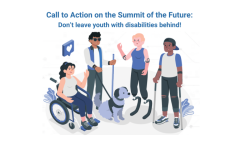
What is assistive technology?
During the last decades, assistive technology has become a necessary tool to facilitate the inclusion of persons with disabilities.
The term assistive technology does not only refer to specialised software or digital devices; it also includes simple tools such as a walking stick or prescription glasses. About 70 per cent of adults worldwide wear prescription glasses; this means that if they could not access prescription glasses, a big part of the population would have a disability nowadays.
From prosthetics, hearing aids, and wheelchairs to screen readers and communication software, do you imagine how challenging it would be for some persons with disabilities to live independently without assistive technology? However, not everyone can access it.
On 14th January, ATscale, the Global Partnership for Assistive Technology, hosted "Mobilising for Assistive Technology - Towards the 2nd Global Disability Summit". In the event, the panellists highlighted how only 10% of people in need of an assistive device could access it.
Around the world, there are currently:
- 850 million people in need of eyeglasses;
- 54 million in need of hearing aids;
- 60 million in need of wheelchairs;
- 35 million in need of prostheses.
IDA's Executive Director, Vladimir Cuk, also encouraged governments, organisations, and other relevant stakeholders to make commitments related to assistive technology at the Second Global Disability Summit (GDS22).
What prevents one billion people from accessing assistive technology?
Governments and the general population often perceive the provision of assistive technology as an expense or a charity. However, according to USAID, for every dollar invested in assistive technology, there is a return of $9. Allowing some persons with disabilities to be independent of permanent human assistance facilitates their access to education and work. The acquisition of one single assistive device can change the life of a person with a disability and their family.
Discrimination and stigma against certain groups of persons with disabilities also contribute to hindering their access to assistive technology; for instance, women and girls have less access to assistive technology as their education is more likely to be neglected.
"Access to assistive technology should not be optional. It should be considered an essential element of social policies, and not to do so is a form of ableism," according to Catalina Devandas, former UN Special Rapporteur on the Rights of Persons with Disabilities.
Assistive technology and the COVID-19 pandemic
Since the COVID-19 pandemic started, an explosive world digitalisation has occurred. We have seen education, work, mainstream services, and social interaction migrate to online platforms. This change negatively impacted millions of people, including persons with disabilities, who could not access digital devices. Furthermore, those persons with disabilities who used to have constant human support were left behind due to social distancing and lockdowns.
Even though persons with disabilities need assistive technology the most, they are not being prioritised in the crisis response, and assistive technology is not being provided.
"When assistive technology is not available before a crisis erupts, they will not be available when most needed: in the midst of the crisis, when people with disabilities will find themselves most vulnerable due to isolation, stigma, or dependence on others," said Gilles Carbonnier, Vice President of the International Committee of the Red Cross.
How is IDA engaged?
IDA is a partner of the AT Scale Global Partnership for Assistive Technology. Together with other organisations, governments such as NORAD, the UK, and UN Entities, IDA launched the Partnership in 2018 with the ambitious goal of catalysing action to reach 500 million more people with life-changing assistive technology by 2030.
The Partnership's vision is to enable a lifetime of potential where every person can access and afford the life-changing AT they need.
As a cross-sector partnership, the idea is to catalyse change, amplify existing work, and coordinate and mobilise global stakeholders with unified strategies to increase availability and access to affordable and appropriate assistive technology.
